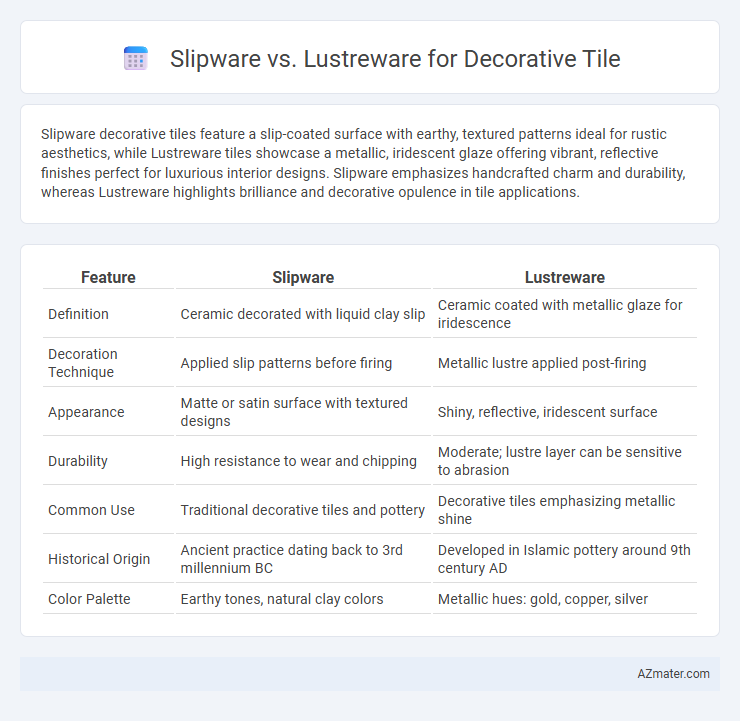Slipware decorative tiles feature a slip-coated surface with earthy, textured patterns ideal for rustic aesthetics, while Lustreware tiles showcase a metallic, iridescent glaze offering vibrant, reflective finishes perfect for luxurious interior designs. Slipware emphasizes handcrafted charm and durability, whereas Lustreware highlights brilliance and decorative opulence in tile applications.
Table of Comparison
| Feature | Slipware | Lustreware |
|---|---|---|
| Definition | Ceramic decorated with liquid clay slip | Ceramic coated with metallic glaze for iridescence |
| Decoration Technique | Applied slip patterns before firing | Metallic lustre applied post-firing |
| Appearance | Matte or satin surface with textured designs | Shiny, reflective, iridescent surface |
| Durability | High resistance to wear and chipping | Moderate; lustre layer can be sensitive to abrasion |
| Common Use | Traditional decorative tiles and pottery | Decorative tiles emphasizing metallic shine |
| Historical Origin | Ancient practice dating back to 3rd millennium BC | Developed in Islamic pottery around 9th century AD |
| Color Palette | Earthy tones, natural clay colors | Metallic hues: gold, copper, silver |
Introduction to Slipware and Lustreware Tiles
Slipware tiles are crafted using a liquid clay slip applied to the surface before firing, creating textured, earthy patterns with a rustic appeal. Lustreware tiles feature a metallic glaze achieved through the application of a thin layer of metal oxides and subsequent reduction firing, resulting in iridescent, reflective finishes. Both slipware and lustreware techniques offer distinct decorative effects, enhancing tile artistry with traditional craftsmanship and unique surface aesthetics.
Historical Origins of Slipware and Lustreware
Slipware originated in ancient Mesopotamia around 3500 BCE, characterized by its use of liquid clay slip to create decorative patterns on pottery surfaces before firing. Lustreware, developed during the Islamic Golden Age around the 9th century in Iraq, involves applying a metallic pigment that produces an iridescent sheen through a specialized firing technique. These distinct historical origins reflect the cultural and technological advancements that shaped the decorative tile traditions in their respective regions.
Key Differences in Materials Used
Slipware decorative tiles are created using a technique where liquid clay slip is applied to the tile surface before firing, resulting in a textured, often matte finish. Lustreware tiles incorporate a metallic glaze that produces a shiny, iridescent effect due to the application of metal oxides during a secondary firing. The key material difference lies in slipware's use of clay slip for decoration versus lustreware's specialized metallic glazes that create reflective surfaces.
Techniques Involved in Slipware Tile Creation
Slipware tile creation involves applying a liquid clay slip, often colored with metallic oxides, onto a leather-hard earthenware body, allowing intricate designs and textures to develop. The technique includes layering slips through methods such as trailing, brushing, or dipping, followed by controlled firing that enhances surface contrast and glaze responsiveness. Unlike Lustreware, which relies on metallic glaze applications producing iridescent finishes, Slipware emphasizes decorative slip patterns integrated into the tile's surface before glazing.
The Artistry Behind Lustreware Tiling
Lustreware tiling showcases a radiant metallic glaze that reflects light with an iridescent shimmer, creating a vibrant, eye-catching finish that elevates decorative tiles beyond the matte or muted tones typical of slipware. The artistry behind lustreware involves intricate layering of metallic oxides and a precise firing process, producing rich color variations and depth that enhance the visual complexity of tile surfaces. This technique distinguishes lustreware tiles as luxury art pieces, preferred for their luminous quality and ability to transform architectural spaces with dynamic, decorative appeal.
Aesthetic Appeal: Colors and Finishes Compared
Slipware decorative tiles feature rich, earthy colors with a matte or satin finish, achieved by applying liquid clay slips that create a textured, handcrafted look. Lustreware tiles boast iridescent, metallic hues with glossy, reflective surfaces that introduce a vibrant, luminous quality to any space. The choice between slipware's warm, rustic charm and lustreware's shiny, jewel-like brilliance depends on the desired visual impact and design style.
Durability and Maintenance Considerations
Slipware tiles feature a porous slip coating that absorbs moisture, making them less durable and requiring sealing to prevent damage. Lustreware tiles have a glassy, metallic glaze that offers superior resistance to scratches, stains, and moisture, enhancing their durability for high-traffic areas. Maintenance of lustreware is easier due to its non-porous surface, while slipware demands careful cleaning and periodic resealing to maintain its appearance and integrity.
Popular Applications in Modern Interior Design
Slipware and Lustreware offer distinct aesthetics for decorative tiles in modern interior design, with slipware prized for its textured, hand-crafted appearance and typically matte finish that complements rustic or bohemian styles. Lustreware tiles feature a metallic glaze that creates a reflective, iridescent surface popular in contemporary kitchens and bathrooms for adding a touch of luxury and visual intrigue. Both materials are employed in backsplash designs, feature walls, and flooring, where slipware emphasizes artisanal warmth and lustreware provides a sleek, modern elegance.
Cost Factors: Slipware vs Lustreware Tiles
Slipware tiles typically cost less due to simpler glazing techniques and lower material expenses, making them a budget-friendly option for decorative tile projects. Lustreware tiles involve more complex firing processes and metallic finishes, which increase production costs and result in higher retail prices. Choosing between slipware and lustreware tiles depends on project budget constraints and the desired aesthetic impact.
Choosing the Right Decorative Tile for Your Space
Slipware tiles, characterized by their earthy, matte finish achieved through slip application, offer a rustic and tactile aesthetic ideal for creating warm, textured spaces. Lustreware tiles, distinguished by their shiny, metallic glaze, provide a reflective surface that adds elegance and a vibrant focal point to contemporary interiors. Choosing between slipware and lustreware depends on the desired ambiance: opt for slipware to evoke natural warmth and handcrafted charm, or select lustreware to introduce glossy sophistication and visual depth to your space.

Infographic: Slipware vs Lustreware for Decorative tile
 azmater.com
azmater.com